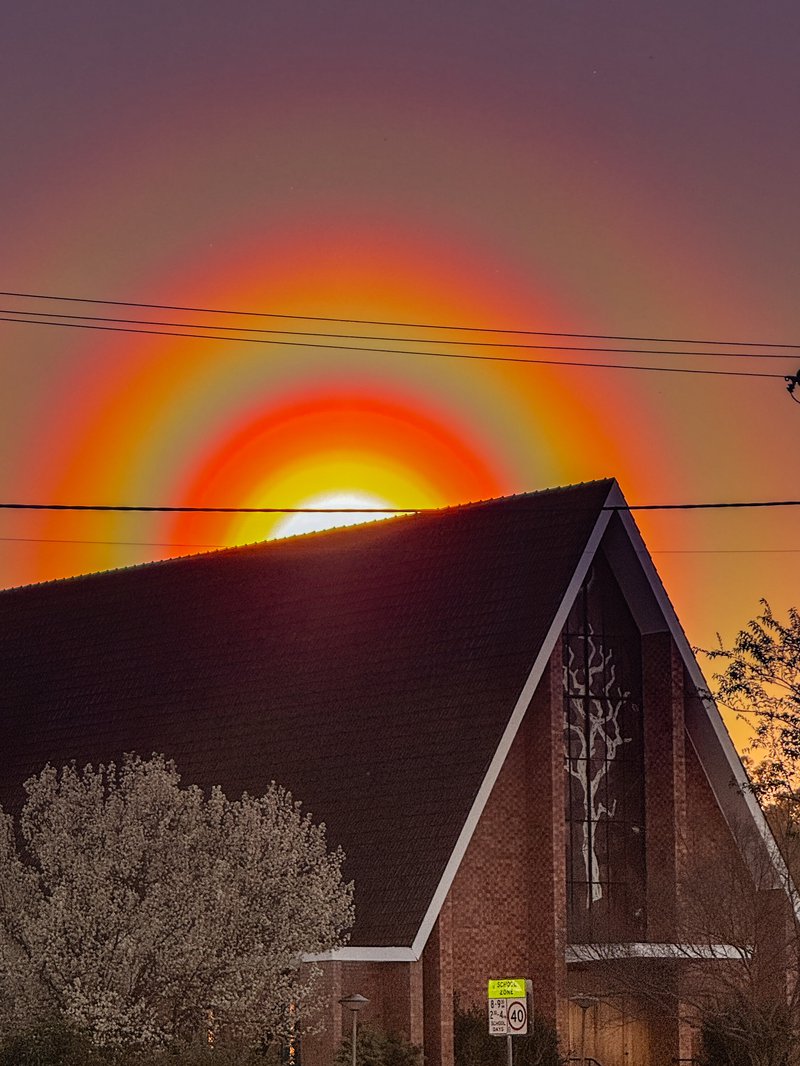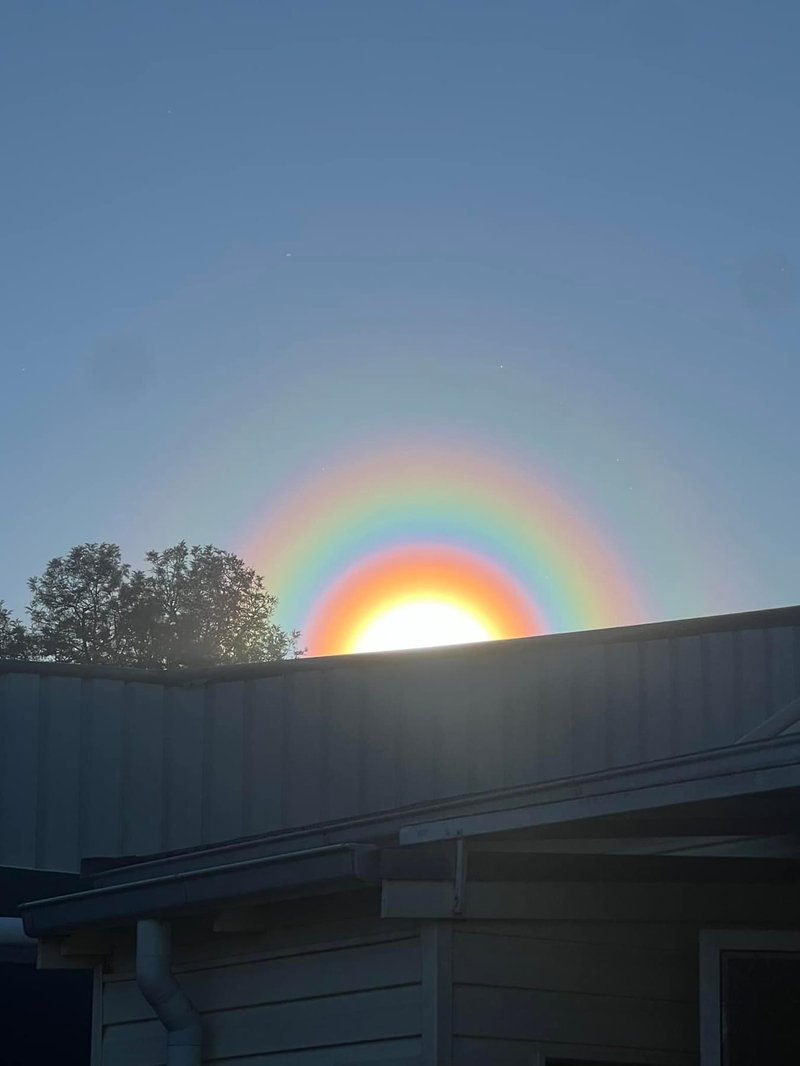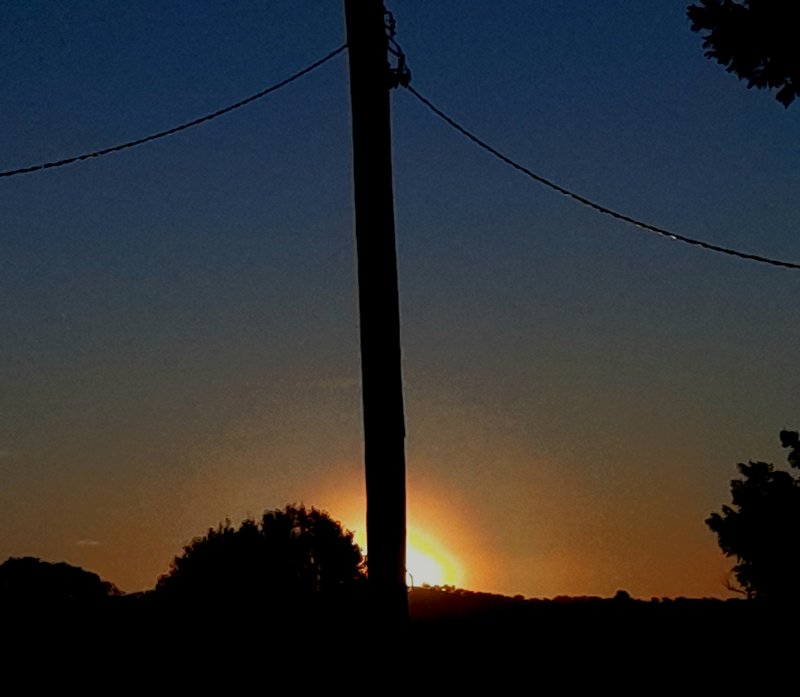Rare pollen coronas seen in NSW
Sept. 13, 2024
We’re fascinated by everything related to pollen, so when Rob McNaught, a retired astronomer from Coonabarabran in inland New South Wales, emailed us about pollen coronas, we were immediately interested. And if you’ve never heard of pollen coronas, don’t worry—you’re not alone! We hadn’t either.

Pollen corona over Coonabarabran church. Picture: Ryan Unicomb.
Let’s start with what a corona is (and no, it’s not related to the coronavirus).
A corona is an optical effect that happens when sunlight (or moonlight) passes through clouds of tiny particles. As the light passes, each particle bends and splits the light, causing bright areas where the light waves come together (constructive interference) and darker areas where they cancel each other out (destructive interference). When there are many particles of the same size, this creates a corona—a series of colourful rings around the sun or moon, usually in shades of yellow, green, red, or blue.
Various types of particles, such as water droplets, ice crystals, dust, and pollen, can create a corona. However, because pollen grains are relatively large, the coronas they form tend to be small and easily obscured by the glare of the sun or moon. That means to observe a pollen corona, the light source must be partially blocked by something like a tree branch, roof, or power pole. The right conditions are also essential: warm air to lift clouds of a single type of pollen grain higher into the atmosphere on a dry, calm, and clear day. In August, which was the warmest in Australia since 1910, a stubborn high-pressure system over eastern Australia helped create the perfect conditions.

Pollen corona seen over a house in a Coonabarabran. Picture: Shona Rankin.
Not all types of pollen create coronas. In the northern hemisphere, coronas are most commonly observed near pine and birch forests, as these trees release a significant amount of airborne pollen. However, in Australia, coronas seem to be less common because our forests are dominated by eucalypts, trees that depend on birds and insects for pollination. There is, however, one type of forest in Australia that seems to have the right kind of wind-pollinated trees for pollen coronas: the Callitris forest.
Callitris forests are usually found in small patches in drier inland regions but sometimes cover large areas. These trees release such large quantities of pollen that it can resemble smoke. Most of Australia’s Callitris forests are in the Central West and New England regions of New South Wales, with the largest area being the iconic Pilliga Forest. Towns in and around the Pilliga, like Coonabarabran, Baradine, and Narrabri, are therefore probably the best places in Australia to see a pollen corona.
In late August, everything aligned –the weather, the pollen and good observers armed with mobile phones.

Pollen corona around the setting sun in Mudgee: Picture: Steven Quirk.
On August 27, late in the afternoon, Ryan Unicomb captured a stunning image of a multi-hued pollen corona over a church in Coonabarabran. As reported by Liz Cutts on the Western Plains App website, Shona Rankin took an equally impressive photo of a corona while hanging out the laundry in her backyard,also in Coonabarabran. Meanwhile, a couple of hundred kilometers to the south, Steve Quirk, an amateur astronomer with 40 years of experience, photographed a corona around the setting sun on his farm near Mudgee. The Pilliga is too far from Steve’s farm to be the pollen source; instead, the Callitris-dominated forests at Munghorn Gap Nature Reserve and Goonoo are more likely candidates.
Is it possible to see pollen coronas in other parts of Australia, such as Melbourne? While Melbourne's main pollen type is cypress, a relative of Callitris, there likely aren't enough cypress trees in the city to create the pollen clouds required for a corona. The city's famously unpredictable weather further reduces the likelihood. In addition to Callitris, wind-pollinated trees like she-oaks and pines are also found in Australia, and if enough of these trees are present and conditions are suitable, they too could potentially produce pollen coronas.
Though pollen coronas are elusive, the recent sightings in New South Wales show that they can occur in Australia when the right conditions are right. So, if you're lucky enough to see one, why don't you share a photo with us on on X (formerly Twitter) and tag us in or use the hashtag #PollenCorona?


